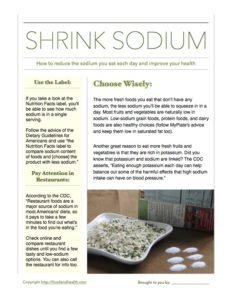3 Top Tips to Lower Sodium
Here are the stakes:
"Americans consume too much sodium. High sodium consumption raises blood pressure, and high blood pressure is a major risk factor for heart disease and stroke. Heart disease and stroke are the nation’s first and third leading causes of death" (source).
Now it's time to do something about it.Here are 3 ways to lower sodium intake. Teach them to your clients. Incorporate them into your displays and wellness fairs. Send them in emails. Just keep spreading the word.Tip #1: Eat More Fresh Fruits, Vegetables, and Low-Sodium Foods.The more fresh foods you eat that don't have any sodium, the less sodium you'll be able to squeeze in in a day. After all, if you're too full from eating low-sodium foods, you won't have any room for high-sodium snacks.Most fruits and vegetables are naturally low in sodium. Low-sodium grain foods and dairy foods are also healthy choices (follow MyPlate's advice and keep them low in fat too) as are low-sodium protein foods. It's harder to find low-sodium protein foods, so make sure to check the label. After all, according to the CDC, "before it arrives at the grocery store, raw chicken and pork can be injected with a sodium (or saline) solution which increases sodium content significantly."Another great reason to eat more fresh fruits and vegetables is that they are rich in potassium. Did you know that potassium and sodium are linked? The CDC asserts, "In general, people who reduce sodium, who increase potassium, or who do both benefit from having lower blood pressure and reducing their risk for other serious health problems. Eating enough potassium each day can help balance out some of the harmful effects that high sodium intake can have on blood pressure. But lowering sodium intake is key to this balance."Tip #2: Use the Nutrition Facts LabelThe Nutrition Facts panel is your friend. If you take a look at the label of a food, you'll be able to see how much sodium is in a single serving. With some simple math, you can calculate how much sodium is in the whole package too.Know your numbers:
- Very low in sodium: 35 mg of sodium or less per serving
- Low in sodium: 140 mg or less per serving
Look at the % Daily Value:
- 5% or less is low
- 20% or more is high
Follow the advice of the Dietary Guidelines for Americans and use "the Nutrition Facts label to compare sodium content of foods and [choose] the product with less sodium."Remember, the CDC maintains that "Knowing which foods are the biggest contributors to sodium in your diet is an important step in reducing daily sodium intake to a healthy level. To figure out the amount of sodium in a food, check the Nutrition Facts label, which lists sodium content per serving."Tip #3: Pay Attention When Dining OutThis tip is all about research.It's one of the top tips from the CDC, which asserts, "Restaurant foods are a major source of sodium in most Americans' diets, so it pays to take a few minutes to find out what’s in the food you're eating. Planning ahead also can help you find restaurants that have information on sodium levels in the foods they serve."Check online to see if the restaurant you're planning to visit publishes nutrition information. If it does, check out the dishes, comparing them until you find a few tasty and low-sodium options.If the restaurant doesn't publish nutrition information for its dishes, consider calling it up and asking about low-sodium choices.You can even ask your server to recommend some sodium-light dishes when you're choosing from the menu. Consider asking that no salt be added to your food. And remember to watch for hidden sources of sodium, like salad dressings or sauces, and have those omitted or served on the side.Why follow these tips?Because "Americans consume too much sodium. High sodium consumption raises blood pressure, and high blood pressure is a major risk factor for heart disease and stroke. Heart disease and stroke are the nation’s first and third leading causes of death" (source).Reduce your risk.Lighten up on the sodium.Here's a printable nutrition handout with the highlights from today's post. Don't miss these incredible sodium educational resources...[shopify embed_type="product" shop="nutrition-education-store.myshopify.com" product_handle="sodium-math-tearpad" show="all"][shopify embed_type="product" shop="nutrition-education-store.myshopify.com" product_handle="salt-poster-set-3-posters" show="all"][shopify embed_type="product" shop="nutrition-education-store.myshopify.com" product_handle="salt-display-kit" show="all"]
Don't miss these incredible sodium educational resources...[shopify embed_type="product" shop="nutrition-education-store.myshopify.com" product_handle="sodium-math-tearpad" show="all"][shopify embed_type="product" shop="nutrition-education-store.myshopify.com" product_handle="salt-poster-set-3-posters" show="all"][shopify embed_type="product" shop="nutrition-education-store.myshopify.com" product_handle="salt-display-kit" show="all"]


